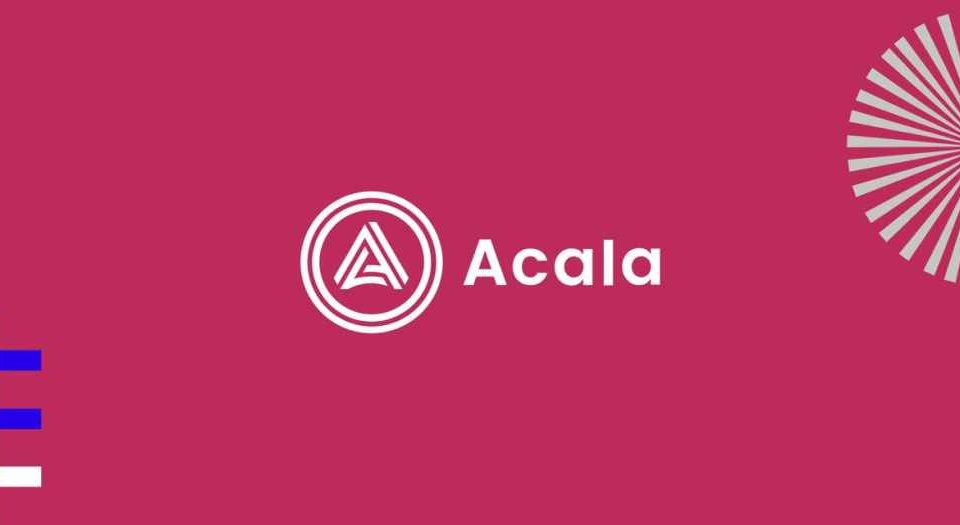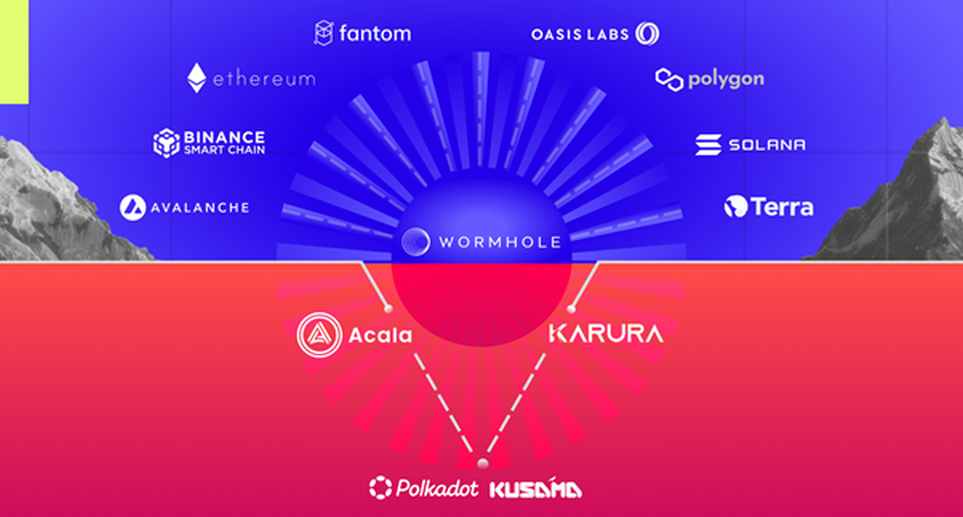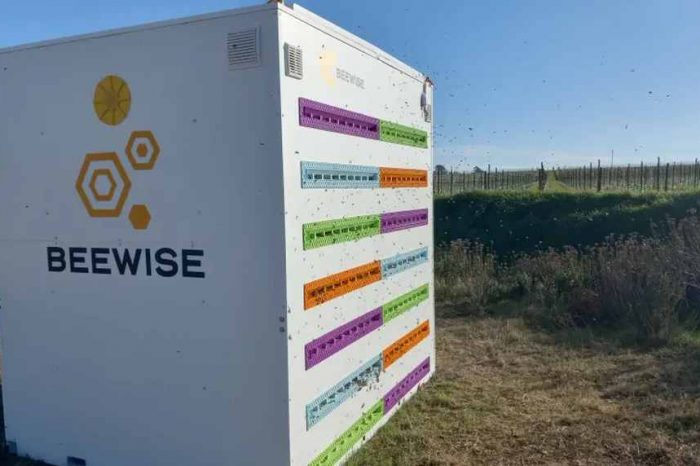Acala and Karura join forces to connect Polkadot and Kusama to the Wormhole Multi-Chain Bridge

Acala, a decentralized finance network powering the aUSD ecosystem, and Karura have joined forces to connect Polkadot and Kusama to the Wormhole Multi-Chain Bridge. As part of the partnership, Acala and Karura ecosystems to join forces with Avalanche, Binance Smart Chain, Ethereum, Fantom, Oasis, Polygon, Solana, and Terra for shared liquidity, cross-chain DApps, and cross-chain token transfers.
The two companies will integrate with Wormhole, an industry-leading multi-chain bridging platform connecting high-value blockchain networks. As the first EVM+ integration on both Karura and Acala, this cross-chain interoperability will enable Acala and Karura users to enjoy asset integrations and access to over $200B of liquidity from leading layer-1 networks.
Karura will be the first to join Wormhole, followed shortly after by Acala. The integration will connect Karura and Acala (and the broader Polkadot and Kusama ecosystem) to eight layer-1 chains, with the list continually growing. Across all chains, the bridge currently has $3.6 billion in total value locked.
Karura and Acala will continue after this integration by building up liquidity on both networks, then beginning to open the EVM+ for the first DApp launches on the networks.
Wormhole Connecting Acala & Karura to the Broader Web3 Ecosystem
Acala and Karura will enjoy several advantages due to the Wormhole integration. The most significant benefits users will enjoy:
Connection to Top Layer-1s
Wormhole is a fully generic network that allows cross-chain messages to contain abstract data and enables developers to create applications on or utilizing Wormhole. Currently, there are two features built on top of the generic message-passing protocol which Acala and Karura DApp developers and users will enjoy:
- A token bridge allowing users to bridge wrapped assets between supported chains seamlessly.
- An NFT bridge that allows ERC721 (Ethereum) and SPL NFTs (Solana) to be transferred between chains.
Wormhole’s integration connects Acala and Karura users to networks already supported by Wormhole, including:
- Ethereum
- Avalanche
- Solana
- Polygon
- Oasis
- Terra
- Fantom
- Binance Smart Chain
Acala and Karura will benefit from Wormhole’s consensus abstraction, speed, and upgradeability mechanics. Consensus abstraction ensures the transaction process remains lightweight to facilitate high throughput during cross-chain transactions, severely limiting bottlenecks and congested usage. Wormhole Guardians protect the protocol from malicious actors and hacking attempts via observation and attestation of all Wormhole transactions.

Cross-chain Assets in Acala’s EVM+
Acala EVM+ provides a development environment analogous to Ethereum and a fully Ethereum-compatible experience for DeFi users (MetaMask), while still getting the full power, speed, and customizability of Polkadot’s modular blockchain framework, Substrate (EVM + Substrate). Upon the upcoming full launch of EVM+, any DApp team can deploy their EVM-based smart contracts onto Acala with minimal changes while using the same tooling they utilize in other Ethereum environments (MetaMask, Truffle, Waffle, etc.). With the integration of Wormhole, this means any DApp built on Acala, or any other parachain connected to Acala, will be able to integrate Wormhole assets for their users. For example, a money market built on Acala will be able to leverage Wormhole ETH as a collateral asset or a stableswap pool built on Acala will be able to integrate USDC via Wormhole.
Bridging Karura and Acala (Stablecoin Merge)
The Wormhole integration will be the first time Karura and Acala are able to communicate and exchange value. This will enable Acala to finalize the merge of the two stablecoins, aUSD and kUSD, for better liquidity and usability (see governance proposal). The union of aUSD and kUSD allows aUSD to serve all parachains in both the Polkadot and Kusama ecosystems as the native, decentralized stablecoin, creating capital efficiency, utility and enhanced liquidity. This will also enable aUSD to be minted on both Acala and Karura with initial collaterals including: DOT, ACA, KSM, KAR, LDOT, and LKSM.
Wormhole Will Accelerate aUSD’s Growth, Liquidity, and Yield Opportunities
Acala intends to employ aUSD as the bridge connecting foreign tokens from different blockchains, thereby increasing the utility and yield for aUSD. The Wormhole connection will create multiple new opportunities for Acala and Karura ecosystems to grow and consolidate while significantly increasing aUSD minting capabilities.
Additional Collaterals for Minting aUSD
Thanks to the Wormhole integration, foreign tokens such as USDC, ETH, SOL, AVAX, or LUNSA can be brought to the Acala and Kusama ecosystems. Users will be able to trade the assets or have Acala potentially approve them as collateral for minting aUSD. The support promotes easy onboarding of users from other networks and allows users to extract liquidity from their collateral assets. Wormhole, combined with Polkadot-native collaterals like Interlay’s trustless BTC, will help aUSD have the most diverse and liquid collateral base of any stablecoin in the market.
Increase aUSD Yield and Utility
Another advantage of the Wormhole connection is the opportunity to increase aUSD yield and utility; the multi-chain interoperability encourages developers to create new use cases for aUSD leveraging assets and DApps beyond the Polkadot and Kusama ecosystems. Users and DApps on other blockchains will also be able to import aUSD to their ecosystems for new yield opportunities. Wormhole’s architecture will also allow greater freedom of aUSD’s movement cross-chain, because it will retain a path independent property among all of Wormhole’s connected networks, so no double-wrapping as it goes from network to network. For example, a user will be able to mint their aUSD on Acala or Karura, send it to ETH, then use it on Solana, then Polygon, then send it back to Acala with no wrapping or transferability issues.
Access to Greater Number of Tokens for DApps
Acala’s Wormhole connection enables DApps to leverage tokens from other chains, such as in a money market or DEX. The bridge mechanism creates supply and demand scenarios beneficial to Acala users, and foreign chains; protocols using the Wormhole network can leverage access to a large market to support their different use cases.
Additionally, Wormhole creates a channel for the usage of LDOT and LKSM products in other ecosystems as collateral, increasing utility and the opportunity to leverage additional DeFi services in multiple crypto networks.
Stable Asset System
The Stable Asset system enables efficient low-risk trading using uniform, closely pegged assets. A Stable Swap is a highly efficient exchange liquidity pool, whereas a Stable Asset is a synthetic asset-backed by a basket of assets with the same value peg. Wormhole’s token bridge allows Acala and Karura to receive stablecoins like USDC to increase the Stable Swap pools on protocols including Tapio and Taiga.
Wormhole Integration to Go Live in Early Q2 2022
Wormhole is coming soon! Upon completion of testing and onboarding processes, Wormhole will go live on Karura very soon in the coming weeks, then on Acala following the Karura integration.
Stay tuned! We’ll be announcing more details as soon as they arise, so follow our social media channels for the latest updates.
$250M aUSD Ecosystem Fund
If you are a developer interested in building a project that drives yield or utility of the aUSD stablecoin, apply for funding from the $250 aUSD Ecosystem Fund.
Build on Acala
If you’re a team looking to build on Acala, integrate the aUSD stablecoin, or receive support from Acala Grants, please get in touch with our team to chat about how we can support you.
We covered Wormhole back in February after hackers breached its network stealing more than $320 million from its site in the second-largest DeFi hack ever. All users breathed a sigh of relief after the crypto platform announced it was able to retrieve all the funds and that “all funds are safe.” Since then, Wormhole has patched the vulnerability and its network back up online.
Wormhole is a generic message-passing protocol that connects to multiple chains including Ethereum, Solana, Terra, Binance Smart Chain, Polygon, Avalanche, Oasis, and Fantom. Smart contracts emit messages through its network, which are sent to a target destination – forming a cross-chain bridge. This system enables cross-chain communication protocols like token and NFT bridges, cross-chain oracles, and other messaging applications that would not operate without Wormhole’s infrastructure.
About Acala
Acala is a decentralized finance network powering the aUSD ecosystem. The core product, Acala USD, is a decentralized, multi-collateral, crypto-backed stablecoin serving as the native stablecoin of the Polkadot ecosystem. Acala’s Ethereum-compatible blockchain has built-in DeFi protocols for application developers to leverage, including a trustless staking derivative (liquid DOT — LDOT), a decentralized exchange, and the EVM+, a hybrid EVM offering fully Ethereum-compatible development environment plus full compatibility with Substrate.

